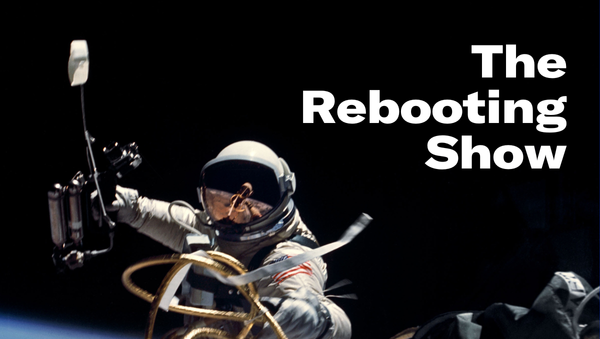Reality checks
Publishing needs a come to Jesus
Cannes is approaching. Please check out all the events The Rebooting has going on, and submit your information for invitations.
Also a reminder to peruse the state of publisher ad revenue report we did with our partners at Permutive. The glass is half full at the 99 publishers we surveyed.
Now onto some reality checks and a new PvA episode about the forces of compression unleashed on publishing, marketing and beyond.
Reality checks
Earlier this year, a big news company asked if I’d speak to an offsite executive gathering. I asked the brief, since I tend to know there’s a reason you get trotted out. “We need to instill urgency,” was the reply.
For all the external challenges facing the publishing business these days, the biggest challenge for many organizations is overcoming complacency that sets in within any human organization.
Over my time covering this industry’s fitful transition to digital business models, I’ve noticed the gravitational pull of complacency from within legacy organizations that often chews up those embarking on meaningful change because change sucks. (As Rishad Tobaccowala says, while change sucks, irrelevance is worse.) Part of that is candor. Quibble with his use of the second person, but the Washington Post’s Will Lewis was using candor to instill urgency when reminding recalcitrant staff that this is a money-losing business that has a product problem. The blame game – journalists blame management and vice versa – doesn’t do much.
Part of the need to set what I like to call a new growth agenda for publishing requires being real about the current situation.
The AI deals are good business. Criticisms of the deals publishers are making with OpenAI are easy to come by. We’ve seen this movie before, etc. But let’s be real: Publishers have no leverage right now, and millions falling immediately to the bottom line is not going to be turned down to “take a stand.” Business isn’t about fairness.
The best approach is to look at the money as a transformation grant. One Australian publisher told me of treating the money wrung from tech giants through the News Bargaining Code hustle this way. And, as The Atlantic CEO Nick Thompson noted, recognize these “partners” will always pursue their own interests that wax and wane with their need for publishers.
Unions need to play a productive role. The economics of these businesses has shifted and will shift even further. The upsurge in union activism in publishing caught me off guard, but it’s here to stay. I understand the pressures and inequities of this profession – I had roommates in my 30s – and still don’t see how the constant clashes with management has improved anything in these businesses. The reality is layoffs haven’t spared unionized companies. Many publishers who went out of business were unionized.
What’s needed is more akin to what happened during the financial crisis with the auto unions. They put aside their battles to get to the other side of what was an existential crisis. That means skipping the performative protests and accepting the reality of the structural changes to this industry that require restructuring to restore competitiveness in a market that will only grow more competitive.
The authenticated web is a smaller web. The fate of the open web is a frequent matter of debate. I was at an event yesterday in which the threats to the open web were laid bare. Digital advertising is in transition. The third-party cookie’s exit means rebuilding how the system works. For now, the benefits are clearly accruing to closed networks. That’s because the real challenge of signal loss in digital advertising isn’t so much targeting but in measurement. Marketers will eventually adapt to have more sophisticated econometric models that aren’t so blunt and focused on the bottom of the funnel. Measurements of attention will help.
The weight of focus for many is in authentication, ie having people give their own data. This deterministic data is typically more accurate than probabilistic data, but there’s going to be far less of it. CNN’s move to get more people to log in is a sign of things to come. This is hard to implement in the face of declining traffic because the reality is most people bounce when hit with that kind of friction.
The reality is the open web will cease to be free range and become more like Phoenix, where I have spent many frustrated runs that constantly dump me in cul-de-sacs. A sliver of most publisher’s audiences will authenticate. Like all other things in the media business, this is no savior. Authentication and first-party data will be a valuable signal but one of many.
Advertisers aren’t here to save publishing. The loss of ad dollars to publishers has many causes, but the biggest is simple: They got beat in the marketplace. Google, Facebook et al created far better ad systems, and they made it easy to buy and run ads. The complaints about keyword blocklists and news avoidance are valid. Yet the reality is marketers wouldn’t stand for such blanket bans if they knew advertising in these environments is critical to their business goals.
Advertising is growing. Only the growth is being captured by others, and no longer is the boogeyman “the duopoly.” Retail media will go from a negligible channel to represent up to 20% of total ad spending this year. That money isn’t all from the shelf-taker budgets.
Subscriptions have a ceiling. The “subscriptions wall” is a popular talking point. Common sense holds that not every web property can have a thriving subscriptions program. The New York Times is an outlier in many ways. Subscriptions are part of the answer at many publishers, but simply won’t work in most lifestyle and entertainment areas. And even in news, the success of the Times is both an inspiration and impediment to other news publishers.
The Washington Post will introduce new ways to wring consumer revenue. This is needed. Subscriptions are less sophisticated in publishing as they are in other businesses. Think of the many ways gaming has implemented rather than the blunt approaches of publishers. If subscriptions are rejected by 95% of the audience, that's a sign. The $1 offer hacks will erode audience trust and make claims to being "premium" difficult to square in the long run Now is the time to experiment. (House of Kaizen’s Matt Cronin and I discussed this on this week’s episode of The Rebooting Show.)
“Traffic” still matters. Sometimes I can fall for sweeping statements like “the end of the traffic era.” They make for good headlines. But again reality intrudes. One publisher wrote me recently with a helpful reminder that while waving “engagement” around sounds good, the data can tell a different story.
“We’ve found session depth (pv/visit) means little. Daily visits/user is the game. And maybe a ‘visit’ is a daily engagement like a visit or an audio listen, newsletter open, Instagram Reel view etc is the game. Hard data problem but subscription businesses don’t think about session depth.”
This is a subtle but important point. The goal for publishers should be around building habit and establishing products that appeal to different audience segments that are supported by different business models. And above else, it’s a reminder that publishers should be realistic about the role they play in people’s lives. They are battling for relevance with every TikTok, every Reel, every YouTuber.

The biggest challenge for 1XL was finding a video technology provider that could accommodate all of its portfolio’s variances–which consists of 43 local and regional news publishers including Newsquest. The solution? EX.CO, recently named “Best Video Platform” by Digiday, which helped 1XL double its monthly revenue within 3 months. Learn more.
Compression

This week’s People vs Algorithms, we cover the compression happening across publishing, marketing and perhaps even software itself. Topics covered include:
- Webpages will be a niche product. A PvA listener makes the point that: “The mass audience will easily adopt generative AI leaving media brands far smaller and less important than they are today.”
- The end of software: Are the same forces unleashed that killed media coming for software development as the cost of creating it goes to zero just as the cost of creating content went to zero?
- AI + marketing: Klarna says it cut marketing expenses by 25% through AI, particularly agency spending.
- AI hype check: The billions being poured into infrastructure aren’t resulting yet in profits. Eventually shareholders will grow grumpy. And many AI products are half baked, even to the point of catching fire.
- Navigating change: We examine the challenges at The Washington Post and The Wall Street Journal as new leaders look to implement change agendas against internal resistance.
Listen to PvA on Apple | Spotify | other podcast platforms
Thanks for reading. Send me a note with your thoughts by hitting reply or using bmorrissey@therebooting.com




